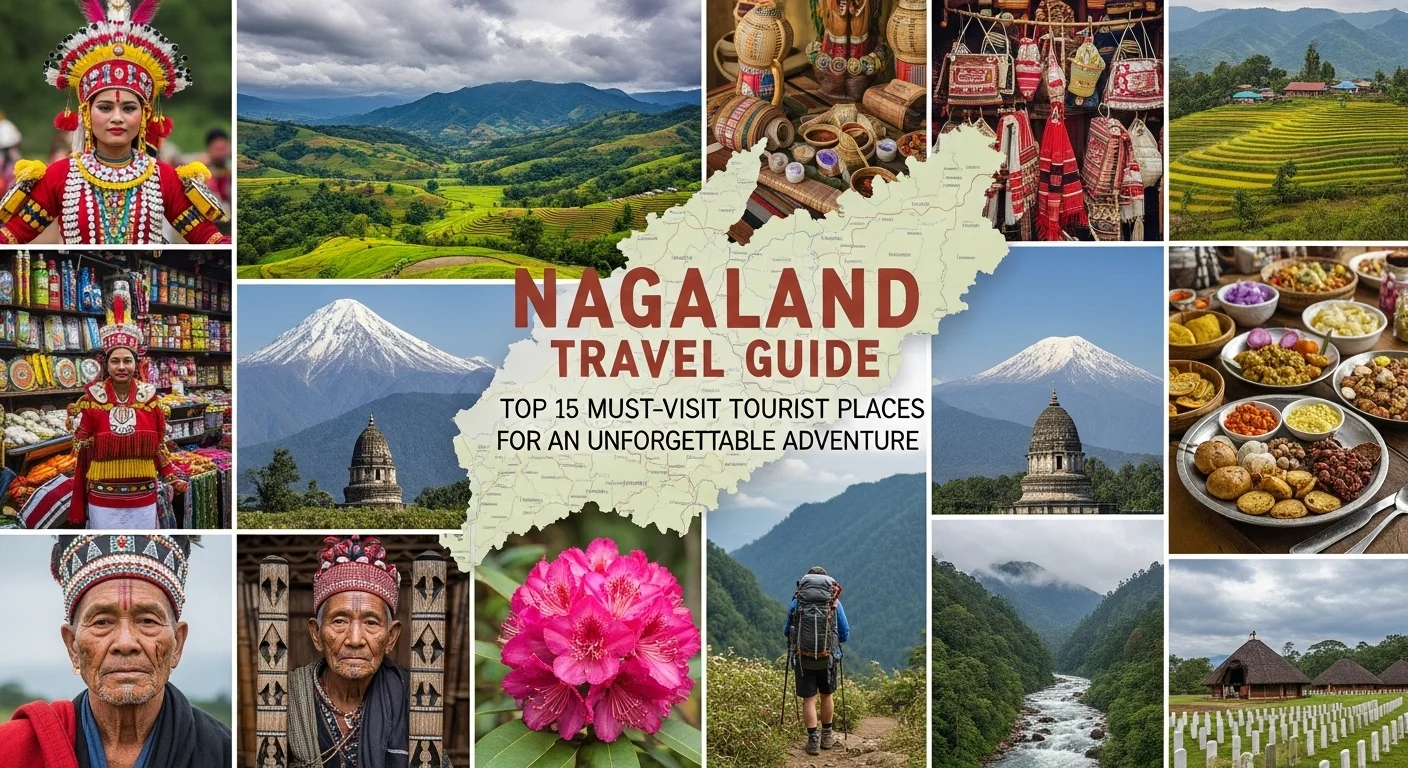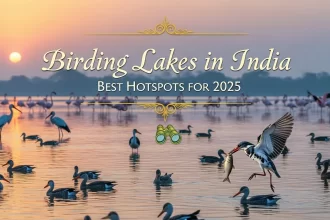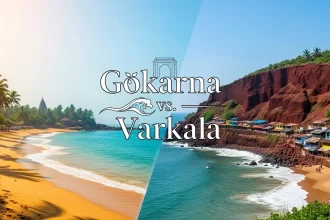India, a land often defined by its historical monuments and bustling cities, holds a secret for those willing to venture off the beaten path. This secret is Nagaland, a jewel in the crown of Northeast India. Far from the typical tourist trail, this state is a vibrant tapestry of lush hills, ancient cultures, and breathtaking natural beauty. For the traveler seeking a truly different kind of escape, a journey here is a chance to step into a world where time-honored traditions thrive and the spirit of adventure is alive and well. This comprehensive Nagaland travel guide is your key to unlocking this extraordinary land. It highlights 15 must-visit places in Nagaland that promise to turn your trip into an unforgettable adventure.
Discovering the Heart of Nagaland
Nagaland’s unique character stems from its fascinating cultural heritage and challenging landscape. The state is home to 16 major Naga tribes, each with its own distinct dialect, customs, and traditional attire. A deep dive into Nagaland culture reveals a society built on community, respect for nature, and a rich history of oral traditions. These Naga tribes celebrate life with a passion that is palpable, and nowhere is this more evident than at the Hornbill Festival, an annual spectacle that brings all the tribes together in a magnificent display of dance, music, and food. This festival is often considered the highlight of Nagaland tourism.
For those with a spirit of exploration, Nagaland is the ultimate destination for adventure travel Nagaland. Its rugged terrain, dense forests, and high peaks provide the perfect backdrop for trekking, hiking, and exploring remote villages. The state’s natural beauty remains largely untouched, offering a pristine environment for both nature lovers and thrill-seekers. It’s a place where you can truly get away from it all.
The Top 15 Must-Visit Places in Nagaland
Here is a curated list of places to visit in Nagaland, designed to give you a complete experience of the state’s diversity.
1. Kohima: The Capital with a Poignant Past
The capital city of Nagaland, Kohima, holds a significant place in Indian history. It’s renowned for the Battle of Kohima, which was a pivotal turning point in World War II. Beyond its historical significance, the city is a vibrant hub of Naga life and culture.
- Key Attractions: The Kohima War Cemetery is a solemn and beautiful tribute to the soldiers who died in World War II. The nearby Naga Heritage Village is a perfect replica of a traditional Naga village and a must-visit during the Hornbill Festival. The State Museum provides deep insights into the history and traditions of the Naga people.
- Experience: History, culture, and a glimpse into tribal life.
- How to Reach: The nearest airport and railway station is in Dimapur. From there, one can hire a shared or private taxi to reach Kohima.
2. Dzukou Valley: The Valley of Flowers
Nestled at an altitude of over 2,400 meters, Dzukou Valley is a magical landscape of rolling hills, lush green meadows, and serpentine streams. It is most famous for its vibrant carpet of wildflowers that bloom in the monsoon season, particularly the rare Dzukou Lily.
- Key Attractions: Famous for its stunning seasonal flowers, a unique landscape, and challenging trekking trails.
- Experience: Nature, trekking, and photography.
- How to Reach: The trek to Dzukou Valley starts from two main points: Viswema village or Zakhama village. Both are easily accessible by road from Kohima.
3. Mon: Land of the Konyak Headhunters
Located in the northern part of Nagaland, Mon is home to the Konyak tribe, once feared for their practice of headhunting. Today, the Konyaks are known for their intricate tattoos and their warm hospitality. Their unique culture and way of life make Mon a truly fascinating destination.
- Key Attractions: Mon, Nagaland, is known for its Konyak tribe, particularly the tattooed elderly men who were once headhunters. Longwa Village, which straddles the India-Myanmar border, is a fascinating place to explore.
- Experience: Cultural immersion, interaction with tribes, and exploring history.
- How to Reach: The nearest airports are Jorhat and Dibrugarh in Assam. From there, one can take a taxi to Mon.
4. Mokokchung: A Blend of Tradition and Modernity
Considered the cultural and intellectual hub of the Ao tribe, Mokokchung is a picturesque town with a pleasant climate year-round. It is a place where traditional Naga practices coexist with modern urban life, making it a unique stop on your journey.
- Key Attractions: The oldest Ao Naga village, Ungma, is a living museum of their culture. Longkhum village is considered the home of the Ao-Nagas.
- Experience: Ao Naga culture, local handicrafts, and serene hills.
- How to Reach: The nearest airport is Jorhat in Assam, and Dimapur is the nearest railway station. From both, taxis and buses are available to Mokokchung.
5. Khonoma: The First Green Village of India
Khonoma is a historic village that once fiercely resisted British rule. Today, it is celebrated as the first green village in India for its community-led efforts in wildlife conservation, particularly protecting the endangered Blyth’s Tragopan bird.
- Key Attractions: This village is a shining example of community-led conservation and is famous for its traditional houses and scenic beauty.
- Experience: Ecotourism, sustainable living, and nature walks.
- How to Reach: Khonoma is located approximately 20 km from Kohima and can be reached by a taxi from the capital.
6. Wokha: Land of the Lotha Tribe
Wokha is a district inhabited by the Lotha tribe, known for its terraced farms and orange orchards. The region is rich in flora and fauna and offers spectacular panoramic views of the surrounding hills and valleys.
- Key Attractions: The serene Doyang River and the sacred Mount Tiyi offer a chance for birdwatching and scenic views.
- Experience: Birdwatching, scenic views, and orange orchards.
- How to Reach: Dimapur serves as the nearest airport and railway station. From there, taxis and buses ply to Wokha.
7. Phek: Pristine Lakes and Verdant Valleys
Phek is a district of enchanting beauty, characterized by its pristine lakes and rolling hills. It is a tranquil destination that offers a peaceful escape from the bustling city life.
- Key Attractions: Phek is home to beautiful natural formations like Shilloi Lake and Dzudu Lake, which are perfect for a tranquil getaway.
- Experience: Serenity, natural beauty, and trekking.
- How to Reach: The nearest airport is in Dimapur. From Dimapur, one can hire a taxi or take a bus to Phek.
8. Dimapur: The Gateway to Nagaland
Dimapur is the largest city and the commercial hub of Nagaland. While it may not have the picturesque beauty of other districts, it serves as the primary entry point to the state and is rich in history, evident from its ancient ruins.
- Key Attractions: The ancient Kachari Ruins, a series of monolithic structures, are a historical marvel. The Diezephe Craft Village is perfect for shopping for local handicrafts.
- Experience: History, archaeology, and shopping for local crafts.
- How to Reach: Dimapur has the only airport and a major railway station in Nagaland, making it well-connected to major Indian cities.
9. Kiphire: Awe-Inspiring Mountain Ranges
Located in the eastern part of Nagaland, Kiphire is a mountainous district known for its rugged terrain and dramatic landscapes. It is a haven for adventure enthusiasts, offering opportunities for trekking, rafting, and exploring untouched nature.
- Key Attractions: Kiphire is the base for trekking to Mount Saramati, Nagaland’s highest peak, and exploring the Fakim Wildlife Sanctuary.
- Experience: High-altitude trekking, wildlife spotting.
- How to Reach: The nearest airport and railway station is Dimapur. From there, one can take a bus or a shared taxi to Kiphire, though roads can be challenging.
10. Zunheboto: A Birdwatcher’s Paradise
Zunheboto is a district known for its hilly terrain and the home of the Sumi tribe. The town is famous for housing the largest Baptist church in Asia, and the surrounding areas are a delight for birdwatchers due to their rich biodiversity.
- Key Attractions: The largest Baptist Church in Asia, the Sumi Baptist Church, is a major landmark. The Ghosu Bird Sanctuary is a haven for birdwatchers.
- Experience: Spiritual peace, birdwatching.
- How to Reach: The nearest railway station and airport is Dimapur. From Dimapur, it’s a long road journey by bus or taxi.
11. Peren: Untouched Beauty and Tribal Life
Peren is a district in western Nagaland known for its pristine natural beauty and vibrant tribal life. It is home to the Zeliang and Kuki tribes, and its untouched landscapes offer a glimpse into an authentic, off-beat travel experience.
- Key Attractions: This is an ideal destination for offbeat travel India. The serene Benreu village and Mt. Pauna offer a chance to experience the authentic Zeliangrong tribal culture.
- Experience: Untouched beauty, experiencing tribal life.
- How to Reach: The nearest airport is Dimapur. The best way to reach Peren is by taxi from Dimapur.
12. Tuensang: A Cultural Hotspot
As one of the largest and oldest districts in Nagaland, Tuensang is a major cultural hotspot. It’s a place where multiple tribes reside, and its rich history and diverse culture are reflected in its art, artifacts, and traditions.
- Key Attractions: Tuensang is known for its fascinating rock formations, Changsangmongko and Tsadan. The Tuensang Museum provides a great overview of the various tribal artifacts.
- Experience: Exploring rich tribal arts and artifacts.
- How to Reach: The nearest airport and railway station is Dimapur. From there, you can hire a taxi or take a shared vehicle, as it’s a long but scenic drive.
13. Japfu Peak: Trekking to the Sky
Japfu Peak is the second-highest peak in Nagaland and a popular trekking destination for its challenging trails and spectacular views. The peak offers a panoramic vista of the surrounding hills, including the famous Dzukou Valley. It is also home to the world’s tallest rhododendron tree.
- Key Attractions: Trekking routes to Japfu Peak offer a rewarding challenge with panoramic views of the Dzukou Valley.
- Experience: Challenging trek, rewarding vistas.
- How to Reach: Japfu Peak is a trek that starts from near Kohima. Travelers must first reach Kohima and then drive to the base camp, often located in Kigwema village.
14. Touphema Village: A Traditional Homestay Experience
Touphema is a village designed to give tourists a glimpse into the traditional Naga way of life. The village has a resort with traditional Naga huts, where visitors can stay and immerse themselves in the local culture, enjoying folk dances and traditional food.
- Key Attractions: Touphema is a village resort where you can stay in traditional Naga huts and enjoy cultural shows. It’s one of the best things to do in Nagaland for cultural immersion.
- Experience: Authentic cultural immersion, village tourism.
- How to Reach: Touphema is about 100 km from Dimapur and can be reached by road via bus or taxi. It is also a popular day trip from Kohima.
15. Dzulekie: A Hidden Village Retreat
A picturesque village nestled in a valley, Dzulekie offers a serene retreat away from the modern world. Surrounded by lush forests and terraced paddy fields, it is a perfect spot for nature walks, birdwatching, and enjoying the tranquility of rural life.
- Key Attractions: Quiet village life, scenic trails.
- Experience: Solitude, nature exploration.
- How to Reach: Dzulekie is a short drive (about 40 km) from Kohima. Taxis can be hired from Kohima for the trip.
Planning Your Trip and Essential Information
This Nagaland itinerary requires a bit of planning to ensure a smooth and enjoyable trip. Here are some essential travel tips for Nagaland.
- Getting There: The sole airport in Nagaland is in Dimapur, which connects to major cities like Kolkata, Guwahati, and Delhi. The Dimapur railway station also has good connectivity. For international travelers, connecting flights from Delhi or Kolkata are the best option.
- Best Time to Visit: The best time to visit Nagaland is from October to March, when the weather is pleasant and ideal for sightseeing and trekking. If you wish to witness the Hornbill Festival, plan your trip for the first week of December.
- Permits: An Inner Line Permit (ILP) is required for Indian citizens from outside Nagaland to enter the state. Foreign nationals are no longer required to obtain a Restricted Area Permit (RAP), but they must register with the Foreigners Registration Officer (FRO) within 24 hours of their arrival.
- Accommodation: Accommodation options range from hotels in major towns to traditional homestays in villages. Opting for a homestay is a fantastic way to experience local hospitality and get an authentic feel for the culture.
- Beyond Sightseeing: Don’t forget to sample the local food in Nagaland, which is known for its unique flavors and liberal use of smoked meat and local herbs. The local markets are also a great place to find unique souvenirs and handicrafts that showcase the rich Naga heritage.
Conclusion
Nagaland is more than just a destination; it’s an experience that leaves a lasting impression. From the serene hills of Dzukou Valley to the rich cultural tapestry of the Naga tribes, this state offers an adventure that is both thrilling and deeply enriching. This guide to the 15 must-visit places in Nagaland is an invitation to step away from the predictable and embark on a journey of discovery. Whether you are a history buff, a nature lover, or a culture enthusiast, Nagaland promises a travel experience that is truly unforgettable.
Must Read: Top 6 Adventure Destinations in India for Every Thrill-Seeker
FAQs (Frequently Asked Questions)
Q1. Is a special permit required to visit Nagaland?
Ans: Yes, Indian citizens from outside Nagaland must obtain an Inner Line Permit (ILP). Foreign tourists no longer need a Protected Area Permit (PAP) but are required to register with the local authorities upon arrival.
Q2. What is the best time to visit Nagaland?
Ans: The best time is from October to March when the weather is cool and pleasant, ideal for sightseeing and trekking. This period also includes the famous Hornbill Festival in December.
Q3. What is the Hornbill Festival?
Ans: The Hornbill Festival, held annually from December 1st to 10th, is a celebration of the unique Naga culture and heritage. It is often called the “Festival of Festivals” as it brings together all of Nagaland’s tribes.
Q4. How can I reach Nagaland?
Ans: The most common way to reach Nagaland is by air or train to Dimapur, which has the only airport and a major railway station in the state. From Dimapur, you can hire a taxi or take a bus to other destinations like Kohima.
Q5. What is the local food like in Nagaland?
Ans: Local food in Nagaland is known for its distinct flavors, often featuring smoked meat, bamboo shoots, and various local herbs. Rice is the staple, and dishes are generally spicy.
Q6. Are there good trekking opportunities in Nagaland?
Ans: Yes, Nagaland is a paradise for trekkers. Destinations like Dzukou Valley and Japfu Peak offer incredible trails and breathtaking views, making it a key destination for adventure travel Nagaland.
Thank you for trusting Outdoorkeeda as your guide for your travel needs. 🙏







